
In the years between 1989 and 1997, the earliest strong attempts at 3D “first person” games were being fired at the wall. As 1992-93 rolled on, this fire reached a machine-gun rate due to the success of Wolfenstein 3D and Doom. Even now, in the year 2017, I set out on the Internet to research this stuff and unearth titles I’ve never played (or even seen) from that era. Some were surprisingly good, but escaped notice for some reason or another. As can happen all too often, poor timing or not enough publicity may have nailed them to the floor; in other cases, they are simply eclipsed by other releases that blow all competition out of the water.
Blake Stone: Aliens of Gold fell victim to all three of these blights, but is still a solid example of the early first-person shooter template put to creative use. The game uses the same engine as Wolfenstein 3D, notable for its orthogonal game-spaces and its ray-casting technique of point-of-view rendering. The game was conceived and developed by JAM productions, a short-lived enclave formed in 1993 by Jim Row and Mike Maynard. Apogee (developers of the engine used) published Blake Stone, and also lent JAM the services of their legendary music man, Bobby Prince.

In Blake Stone: Aliens of Gold you play as the titular character, recruited by British Intelligence in the year 2140 after distinguishing himself in the Navy. Your assignment is to scuttle the operations of an insidious organization known as STAR, which is led by the nefarious Dr. Pyrus Goldfire. Goldfire plans to conquer the world using an army of expert soldiers combined with a heavy complement of his own genetically engineered monsters… and things are looking like that might not be a pipe dream.

Just like Wolfenstein 3D, the game has separate episodes, played one at a time. Each has 10-11 levels in it, usually representing some building or compound belonging to STAR. Blake begins with a simple sidearm when he steps in the door, but can find all kinds of futuristic weapons to beef up his offensive capability. In addition to health items lying on the floor, Blake can also pop tokens into vending machines for a small pick me up. All of this will prove to be extremely necessary, since each level of each episode is crawling with security officers, as well as a taste of Goldfire’s genetic engineering “miracles.” There are also robots, both ceiling-mounted and mobile, that await the chance to shred you with their integral weapons. One cool thing about Blake Stone is the element of ambiguity among the scientists you encounter; some of the men in lab coats are spies who will offer you info or food tokens, and some will just call for help and start shooting you.
Gallery 1

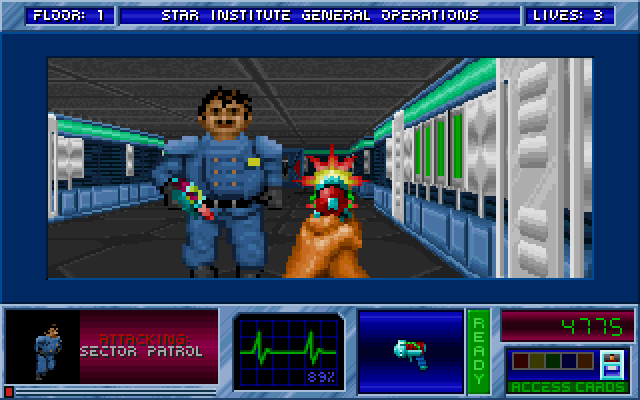
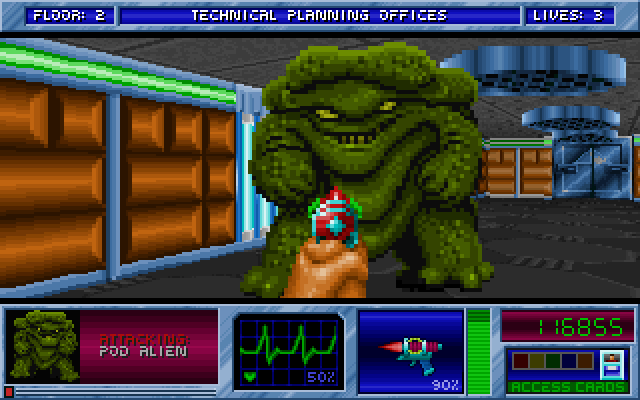
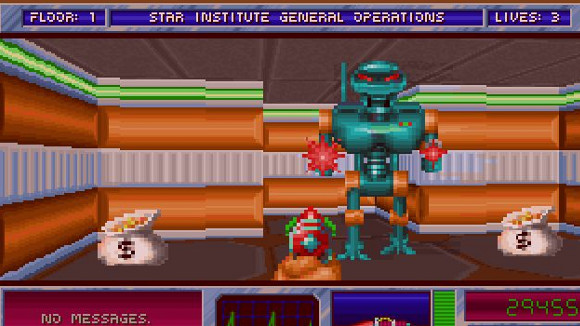

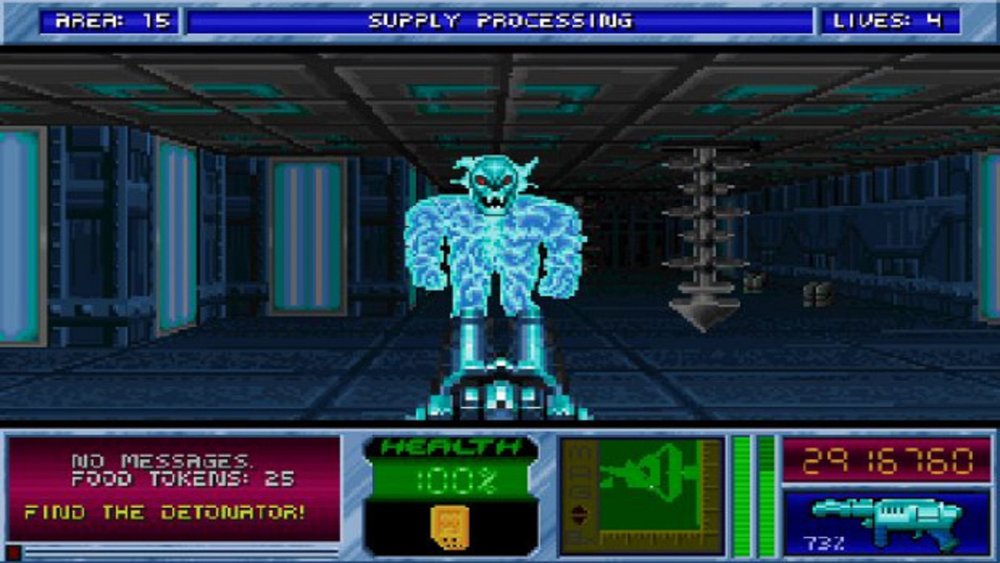
Gallery 2
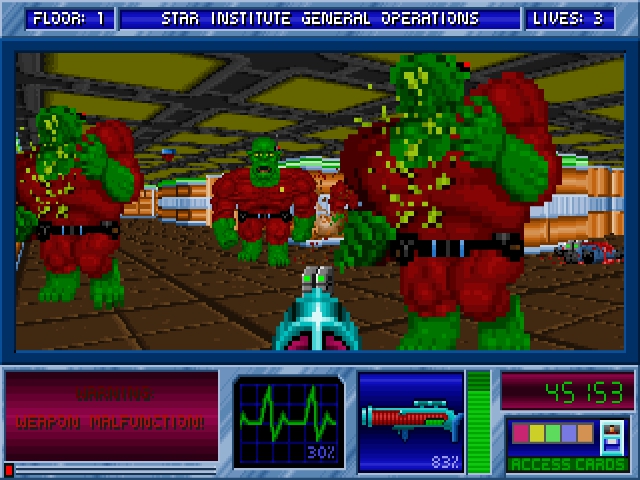
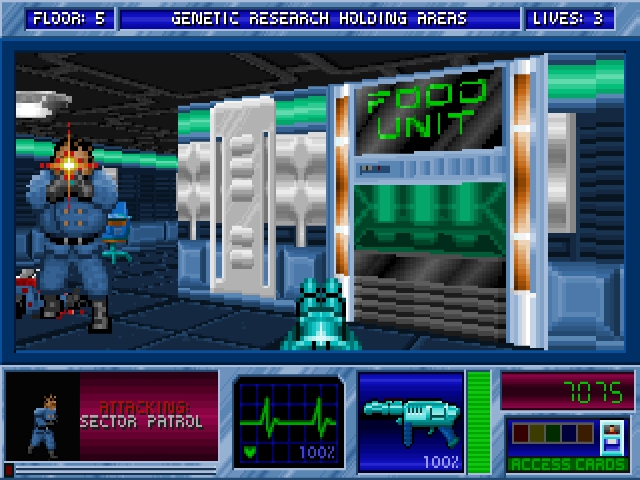
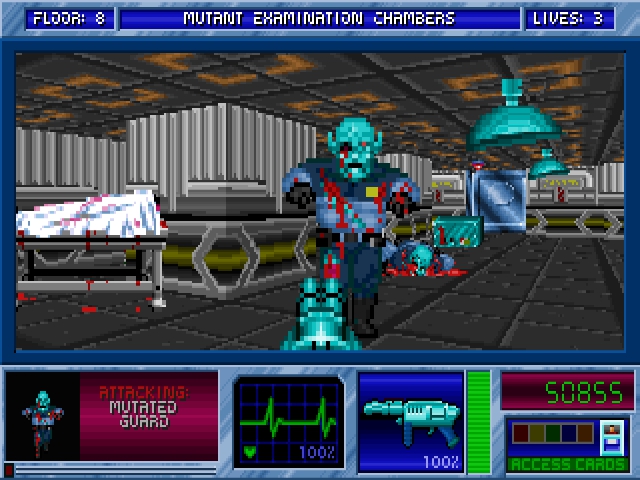

At the end of each episode, you face off with Dr. Goldfire briefly. Each time, he has new tricks up his sleeve, but eventually teleports away before you can finish him off. He’s nice enough to drop the keycard you need to get to the actual boss of that episode, though… and let’s just say they’re locked up for a reason. The end of the final episode lets you finally bring down Pyrus Goldifre, but it’s then that you discover what he really is…

The game’s graphics are about on par with those of Wolfenstein 3D, but they are very colorful and varied. Nothing technical was stretched in terms of visuals, although you can tell a lot more creativity went into them, likely by necessity since this game offers mutants and aliens instead of Nazis as antagonists. A mix of 16 bit and digitized sound is used, with the digitized bits being mostly combat and enemy sound effects. As with most of his work, Bobby Prince borrowed a hook here and there from a rock song but produced a masterful soundtrack of very fitting music. The intro theme and Mission Music #6 are two favorites of mine, but the whole thing is very good. It’s very rich for a SoundBlaster-16/AdLib soundtrack.
Blake Stone: Aliens of Gold was released only a week before id Software released Doom in 1993. As one may guess, Doom completely covered it and most similar games with a mighty shadow, and Blake Stone: Aliens of Gold sold poorly after a good start. It was received well when it was reviewed, however, and was praised especially for its additional gameplay elements and its sound. JAM released a sequel, Blake Stone: Planet Strike, in 1994, and then closed its doors. Its three members found work at other software companies. 3D Realms owns the rights, and has included the game in a couple of compilations as well as a standalone version on their site. It has a gently improved HUD but is otherwise true to the source.
I give Blake Stone: Aliens of Gold 7/10. In hindsight, it stands toe to toe with its peers, and it has a kickin’ soundtrack. It fell victim to poor timing and the shadow of a giant, but it can’t be called a bad game by any means.




